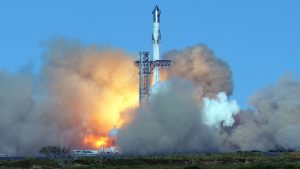Is SpaceX’s Starship the loudest ever rocket?
Watch film of Saturn V launches from NASA’s Apollo program in the 1960s and 1970s, and one thing that stands out – even more than the polyester-heavy clothing and retro hairstyles – is how far away the people are from the main action.
There were several valid reasons for this, including noise: strong sounds may kill, and few human-built structures have been as loud as the Saturn V.
When Apollo astronauts launched their missions to the Moon, they did it more than 3.2 miles (5.1 kilometres) away from the eager spectators. Even from such a distance, the noise was tremendous. A widespread rumour at the time was that the Saturn V’s engines emitted such powerful soundwaves that they melted concrete on the launch pad and lit fire to grass a mile (1.6 km) away.

NASA’s measurements at the time recorded the launch noise as 204 decibels. Compare that to the sound of a jet airliner taking off, which is between 120 and 160 decibels and is deemed harmful to one’s hearing if heard for more than 30 seconds. Even 1.5 miles (2.4 km) away, the boom of a Saturn
“I’m always struck by the physicality of a launch,” says Anthony Rue, a Florida café owner who has been observing and photographing rockets since the Saturn V era. “In the 1970s, an audio gadget known as Sensurround was employed in catastrophe films such as Earthquake to simulate a subsonic earthquake ‘experience’ in the theatre.
“From up close, launches resemble Sensurround,” adds Rue. “You feel a little trembling, followed by a rising rumble in your chest before hearing any actual sound. Subsonic bass frequencies make your ears crackle. After a few seconds, the sound intensifies into a roar, resembling a gigantic welding torch.
Last year, a team of scientists at Brigham Young University in Utah determined how loud Saturn V was. They discovered a remarkably identical finding to Nasa’s own recordings: 203 decibels.
In the big scheme of things, the difference between 160 and 200-odd decibels may not appear to be significant.
One hundred and seventy decibels are equivalent to ten aeroplane engines. “Two hundred would be 10,000 engines,” said Kent Gee, the study’s lead author and physics professor at Brigham Young University at the time. “Every ten dB represents an order of magnitude increase.
Was the Saturn V rocket the loudest ever launched? Probably not if you use thrust as a guide. Saturn V produces 35MN (meganewtons) of force during launch, which is less than the 45MN produced by the Soviet Union’s ill-fated N1 rocket, which was scheduled to send cosmonauts to the lunar surface in the 1960s.
The 33 engines at the base of the Super Heavy booster on SpaceX’s Starship, the heaviest rocket ever launched, provide more than 74MN of thrust. On paper, it should be louder than any previous launch. Certainly, it is quite loud. Gee and his colleagues installed microphones at eight locations around the SpaceX launch complex in Boca Chica during the fifth test flight in October 2024, when the Super Heavy booster landed on the launchpad for the first time. They discovered that during the launch, the rocket emitted noise that could be heard almost 6.5 miles (10.5 km) away. A sonic boom generated as the booster returned to the launchpad produced about 140 decibels at the same distance.
At that distance, the overall noise produced by a Starship launch was similar to standing only 200 feet (61 meters) away from a big passenger aircraft such as a 747 or A380. Gee and his colleagues characterise the sound created during a rocket launch as a low-frequency rumble with brief crackles. The loudness of the Starship launch triggered vehicle alarms in places up to ten miles (16 km) distant.
While it is difficult to say how the Saturn V’s noise would have compared, it was clearly loud enough to warrant consideration beyond spectator hearing. Rockets as strong as the Saturn V might do harm to themselves simply by generating soundwaves from their own launch.





